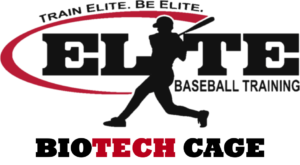
Overall Efficiency Grade: 52.575
Mobility, Flexibility & Stability Screening
Dylan is in the neutral mover category. Had troubled isolating in in his pelvic control test which would indicate weakness in his lower back and lower abdomen.
Disassociation of torso and hips were both limited but improved with assistance. This shows a limited ability to stabilize body parts which will slow energy transfer through the body. We would potentially see 3D rotational velocities slower than their potential.
Thoracic is limited in flexion and extension and on the “neutral” side of rotation with 45 degrees of rotation to the left and 60 to the right. Core has instability which will limit energy transfer / flow from the legs to the rest of the swing. Typically, rotational value numbers will be lower than they should.
Dylan has under-developed scapular region, which will be a focus of his strength plan. There was 4 inches of scapular retraction, which is in the “neutral” category. Shoulder flexion is good as was external and internal rotation.
Both legs showed limited stability, which can cause players to rush their striding mechanism. Both hamstrings and glutes “passed” in functional strength. Internal and external hip rotation were nuetral.
All wrist and cervical screens were a pass.
Force Plate Jumps
Force place jumped showed a left leg bias of 10%. This is in the danger zone of hamstring pulls. We will put unilateral leg work in your strength plan. Squat jump rate of force production and counter movement jump rate of force production were nearly the same. The counter movement jump exploded at 120% of BW at take off. The squat jump was 115% at take off. Gives him some freedom in how he patterns his loading mechanism.
Force Plate Swings
Below is video of the swing analysis. I will walk you through this matched up with video.
Dillon tends to load into his toes more than the heel. We want to create more heel pressure in the load for greater loading force. He also overloads, causing him to get more of the weight and pressure on the outside of his foot. He creates 106%-112% of body weight in his back leg load, but if we can get him in his heel more, that will be higher yet. Back leg torque number is good at 45 Nm but his back shoe is turned out which lowers that number. Could easily get that to 60Nm if his shoe is straight ahead.
The strength of his swing is his front leg production. I’m looking for 200% body weight in the front leg post and he gets 177% -214% which is good.
His leg to leg transfer speed was good, but higher on swings where he had a more aggressive heel punch into the ground and front leg force was higher. This means he is holding good pressure in the back shoe prior to rotation. His leg to leg transfer varied from 34 to 56 milliseconds. Swings with lower from leg production raised the leg to leg transfer time to 96 milliseconds. 20 milliseconds is excellent.
KVEST Sequencing & Rotational Speeds
The 3d readings are on kinematic sequencing and rotational speeds.

Dillon has potential for good output in his swing and has yet to maximize his ceiling. The graph above was his best swing and his closest to being sequenced. Most of the time his upper body was turning ahead of his legs. I would attribute this to nearing 30 degrees of inward torso turn. 30 degrees is usually the mark where we see players get out of sequence because the torso has farther to go to rotate “open” thus starting the swing from his upper body first. Both his hip and torso rotational values ranked in the “above average” category for age. Hip speed numbers ranged from 705 deg/sec to 756 deg/sec. Torso rotational values were from 775 deg/sec (out of sequence) to 1027 deg/sec. (in sequence). That’s a wide separator that changes bat speed values.
The issue though is the upper body is so over-rotated inward, it forces the arms and torso to start early. Because everything is turning at one time, there is limited energy transfer from the legs to the rest of the body. By aligning the torso better, we should get a better energy flow and sequence.
We noticed from the movement screening that the scapular region was underdeveloped. Once alignment gets better, this should be a focus for him, allowing for more torque, disassociation and speed gains.
Bat Sensor Data
Bat speed on our sensor was 57-60mph, which ranks as “slightly above average for age” compared against people we’ve tested. Hand speed was “slightly above average for age” at 19-21 mph.
Summary & Recommendations
- Hammer the strength plan. I feel like that some of the reduced speed in swings is just a functional strength issue. Especially important are the unilateral leg pieces and scapular strength. It will make a difference in your swing and increase the overall bat speed.
- Get back shoe straight ahead in stance and keep it that way during the load.
- Get consistent with front leg production (punch the ground with front heel).
- Keep shoulder alignment with torso for a chance of better sequencing. This made a dramatic difference in your swing speeds when you were sequenced.



 PRIVATE LESSONS
PRIVATE LESSONS CLASSES
CLASSES CAMPS
CAMPS ELITE TEAMS
ELITE TEAMS ELITE BASEBALL TV
ELITE BASEBALL TV VIDEO ANALYSIS
VIDEO ANALYSIS BIOTECH CAGE
BIOTECH CAGE SHOWCASE
SHOWCASE



